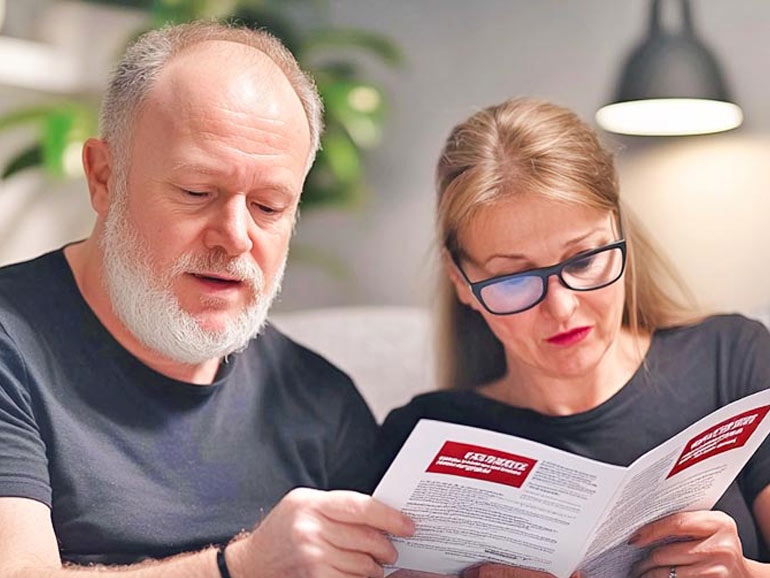The Sales Letter explains how this element looks to establish an important “customer connection.” This It is part 3 in a 6-part series detailing the focused role each component plays in a typical, multi-piece direct mail package. To help better explain these roles, this series draws a comparison between mail components and the presentation strategy used by many successful door-to-door solicitors.
In this Series:
“Offer” references the response incentive offer that a package should be structured around.
“Offering” references the core product or service that is ultimately being solicited.
The Direct Mail Sales Letter: Transcending introduction hyperbole
When it comes to direct mail, the Sales Letter is often a pivotal component that can make or break a campaign. A Direct Mail Sales Letter can be the most influential part of a multi-component direct mail package. Not the first item a recipient sees or looks at — but the one the recipient spends TIME with when he or she is seriously contemplating a positive response to your offer.
The Direct Mail Letter connects with prospects on a deeper level, including but also moving beyond the offer hype to enter the realm of true value that ultimately provides the most detailed and persuasive message.
Connecting with a prospects needs, wants, concerns, and motivations
Think of a sales letter as the “point in time” when a door-to-door salesperson has finally earned the attention and trust of a potential customer. The prospect is now agreeing to sit down, listen, and ask for more details. So it is the letter’s job to provide that crucial information in a way that holds attention, builds confidence and compels action.
Letter design should align with message objectives
Considering these objectives, it makes sense that most sales letters are designed to be “image-light” (if any) and “text-heavy.” The brochure and other elements have delivered the visual “sizzle” – so now the “steak” of what really matters can vibe covered with a “less hyperbole,” more “here are the facts” approach. Letter length is a flexible variable that is determined by complexity of offer, complexity of product, and relationship to prospect (new or prior customer).
Common elements found in a successful Direct Mail Sales Letter:
Reiteration of OFFER VALUE
At the heart of any successful direct mail campaign is the value proposition associated with the package “offer”. The letter should remind the recipient of why responding to the package is a good decision. Whether it’s a special discount, a free trial, or an exclusive bonus, the letter should quickly reiterate the tangible benefits of taking timely action. Often, this can be accomplished with a bolder, larger lead-in headline that reminds the reader of the benefits associated with response prior to diving into greater detail.
Reassure and connect through affirmation and empathy
The best sales letters quickly work to connect emotionally with the reader. A solid intro addresses the reader’s potential concerns or skepticism. It’s an opportunity to say, “I understand where you’re coming from” and “I can imaging what you might be thinking…I get your hesitation.” This begins a channel of open dialogue and trust regarding what is to follow.
Engage through relevant storytelling
A compelling narrative is one of the most powerful tools in a sales letter. A story-driven approach can works wonders, drawing the reader in, with thoughts that allow him or her to believe a situation where they benefit from what is being presented. This helps the reader visualize how the product or service will improve their life. This storytelling can include testimonials or examples of how others have found success by saying “yes” to the offer.
Include subject-related words and phrases
Using trade, industry, or topical words and phrases that tie directly to the product or service you’re offering is an important way to evoke a sense of connection and relevance. The reader should feel confident that the letter (and the product offer) is strongly aligned with their level of their needs desires regarding the product or service subject. It’s not just about selling, but rather detailing how your product or service is the answer they’ve been seeking.
Include bulleted points that detail Features, Advantages, and USPs
After building interest, it’s time to outline the features and advantages of the product or service. A bulleted list can provide a concise, easy-to-read format that highlights what makes your offer stand out. What makes your product unique? Why is it better than the competition (USPs)? How does it simplify life, save time, or provide greater convenience? These are the details that will push the prospect toward a decision to respond to your offer.
Include bulleted points that highlight short and long-term benefits
While features describe the product itself, benefits highlight the positive outcomes the prospect will experience. What’s in it for them? The benefit-focused bulleted list should emphasize how the offer will make the reader’s life better, solve a problem, or bring them closer to a desired goal. Benefits are the emotional hook—the reason why the reader will take action.
Reiterate guarantees and reduce risk
One of the biggest hurdles in direct mail is overcoming the fear of risk. The sales letter should reassure the prospect that their decision is low-risk or even risk-free. Whether it’s through a money-back guarantee, free trial period, or any other form of assurance, make it clear that there’s no or minimal downside to responding.
Include a powerful P.S.
The postscript (P.S.) is considered by many direct mail experts to be one of the most important parts of the letter. This is because the P.S. often captures the reader’s attention right after the headline as they scan the document prior to reading. Usually, the P.S. will reiterate the key benefits and offer value, ending with final call to action. This may include instructions on how to respond, a phone number, a website URL, or an important response deadline. It’s a last nudge to inspire quick action, and also important should the letter become isolated from h rest of the package.
Putting it all together – with a Direct Mail Sales Letter
In the end, the Direct Mail Sales Letter serves as a unifying solution to the “message puzzle” that multi-package campaign can create. The letter ties together emotions, values, benefits, guarantees—and a compelling call to action.
Working with a direct mail professional is the best way to bring the experience and insight needed to combine hyperbole with copy that resonates and compels response. KROHA Creative is ready to craft your next Direct Mail Sales Letter — and entire package — to better ensure direct mail campaign success.


